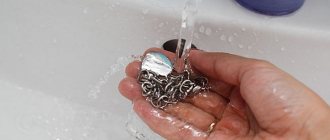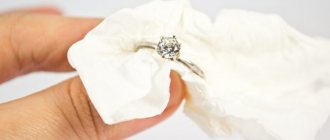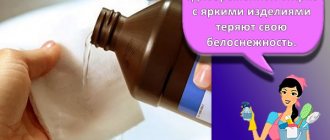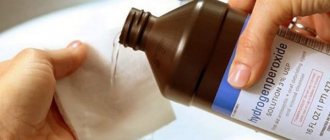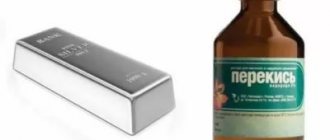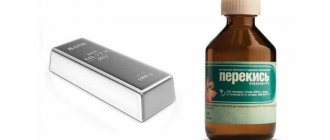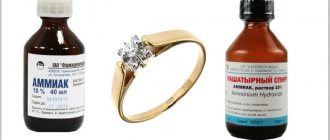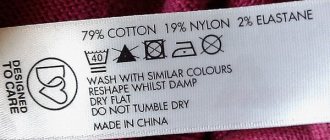White color has been associated with purity and freshness since ancient times. The bedding, dressing gowns, and towels of a good housewife should certainly sparkle like the Alpine peaks and have a pleasant aroma. It is not always possible to bleach laundry at home effectively the first time. However, knowing certain tricks will make it easy to return things to their attractiveness.
Oxygen-containing
This is a new generation of bleaches.
They are able to delicately restore whiteness even without boiling, and are suitable for fabrics of any composition. There are two types of bleaches containing oxygen: in bulk form or in solution form. Their gentle formula allows you to use bleaches as an additive when washing in machines, without requiring pre-soaking. Linen that has turned yellow will become white, and colored items will restore their shade. The cost of bleaching products containing oxygen is significantly higher than chlorine-containing ones.
Why don't all methods work the same?
Having studied the reviews of housewives, we realized that often the same products bring different effects. The fact is that some recipes are suitable for synthetics and cotton, others are contraindicated for artificial polymer fibers, others only work when heated, and others require pre-soaking the clothes.
There are also situations when it seems that the item has turned yellow due to improper washing. But in fact, frequent watering and bleaching procedures simply washed away the white paint, revealing a yellowish or gray base.
Often, homemade bleaching products do not cope with stains due to the persistence of pigments that stain clothes. In this case, you can resort to intensive measures and use chlorine bleaches.
Another reason for the ineffectiveness of methods is the selective activity of bleaching agents.
Drawing a conclusion, let’s say that you shouldn’t stop at one method and be upset that it didn’t help. In case of complex contamination, it may be necessary to use complex treatment. We offer universal methods that work in most cases.
Store products
If you don’t trust folk remedies, using laundry bleach at home will easily remove stains and make your clothes white. You can whiten white items with bleach or bleach.
Add powder and a little bleach to the washing machine, load a white T-shirt and other clothes, select the delicate cycle. After washing, hang things out in the fresh air.
You can bleach things at home using the following bleaches:
- oxygen stain remover Astonish Oxy-Plus Stain Remover;
- Dual Power Pre-Treatment stain remover;
- Vanish Oxi Action stain remover for white clothes;
- stain remover salt Dr. Beckmann.
How to remove yellowness?
White items can turn yellow under the influence of many factors. Sometimes it is quite easy to restore the original whiteness at home, sometimes you have to make an effort, and there are cases when it will no longer be possible to restore the original color, for example, when synthetic fibers have entered into a chemical reaction with chlorine.
Causes of yellowing:
- organic particles;
- traces of perfume or cologne;
- washing in water with a high content of magnesium salts;
- use of untreated water (with rust);
- not thoroughly rinsing after washing (including if the machine’s filter is clogged);
- washing white items with colored laundry powder;
- mold.
Organic particles are traces of our body on clothing. This is not only sweat, but also dead epidermis. If you wear a white item at least once and do not wash it, and then put it in a closet for long-term storage, it will most likely turn yellow. The same thing happens if things are poorly washed after use. You can whiten such yellowness using ordinary laundry soap.
- Soak clothes in cold or slightly lukewarm water for several hours.
- Rub with laundry soap (72%) to obtain a rich, dense foam.
- Pour hot water and soak for about another hour.
- Wash and rinse thoroughly.
- Rub with soap again and repeat washing.
Small yellow spots that appear some time after washing may well be mold. After all, mold on things can be yellow and whitish, and not just black. To deal with such stains, you can use ammonia. For these purposes, both a technical aqueous solution of ammonia (25%) and the well-known ammonia alcohol, a 10% solution, are suitable. It is used as follows:
- in 10 liters of warm water dissolve 1 tablespoon of a 25 percent solution or 4 tablespoons of three percent ammonia;
- things are soaked for several hours and then washed in the usual way;
- When washing, in addition to soap or powder, you can also add ammonia, but in a smaller proportion.
The same bleaching method is used if the water contains a high content of magnesium salts.
If yellowness appears from washing in water that has not been treated with rust, in addition to ammonia, you need to add hydrogen peroxide: 200 ml per 10 liters of water. There are two more recipes that can help cope with this problem:
- soaking in sulfur-containing solutions;
- use of peroxide bleaches.
A sulfur-containing solution can be prepared from ordinary mustard (powder). 100 g of mustard is thoroughly mixed in a small amount of water and then diluted in 10 liters. Things are soaked and then washed in the usual way. The water for soaking should be as hot as possible, so this method is not suitable for clothes that can be washed up to 50 ºC. More effective is the use of peroxide bleaches.
We suggest you familiarize yourself with the smell of sewerage in an apartment, how to get rid of the smell of sewerage
How to properly wash and store white synthetic items so that they do not age? There are several secrets.
- Before washing, sort, separating white items.
- Synthetics, wool and cotton also cannot be washed at the same time, as they have different washing temperatures.
- Before washing, underwear should be soaked in cold water for at least an hour.
- Prepare water for washing: for white clothes, use settled or filtered water, and if the water is hard, soften it with soda.
- Do not store white items ironed.
- Do not use optical brighteners frequently: they can be used no more often than after 3 washes.
- Do not put wet clothes in the closet.
- Make sure that the drain filter in the machine does not become clogged.
If you follow these recommendations, you can prevent “unauthorized” changes in the color of light-colored synthetic items. If such a nuisance has occurred and, while taking out your favorite underwear or blouse from the closet, you find stains, a yellowish or grayish tint, the above tips will help you bleach your clothes at home and enjoy the freshness of your clothes.
Ammonia
Using ammonia, you can bleach natural fabrics that have yellow or gray stains on them.
Please note: this method is not suitable for mixed or synthetic materials.
For five liters of water you need to take one tablespoon of ammonia. First, you need to treat the areas of greatest contamination, then soak the entire product in the solution for several hours. It is important to ensure that the item is completely immersed in water.
Removing stains
For any synthetics, except acetate fabrics, the following mixture is used to remove stains: 5 parts alcohol, 5 parts tartaric acid, 2 parts citric acid. The result of mixing should be a paste. It is applied to the stain and rubbed in 5-10 minutes before washing.
A few more recommendations for removing stains from light-colored synthetics.
- Sweat stains can be washed off if 2 aspirin tablets are crushed and dissolved in 100 ml of cold water, and the resulting solution is applied to the contaminated areas 2-3 hours before washing.
- Grease stains are removed with salt or chalk. Chalk powder or salt is rubbed into the stain, and after a few hours it is removed with a brush. This method is only suitable for fresh stains.
- Ink stains are removed by soaking and washing the stained area in fresh milk or curdled milk.
- You can try to remove the resulting rust stain with lemon. A lemon wrapped in gauze is applied to the stain and pressed with an iron.
Whitening clothes at home is the best way
Among the many effective ways to whiten clothes, the best method among housewives is considered to be boiling, with the addition of peroxide and ammonia. For the cleaning process you will need:
- ten-liter saucepan;
- 9 liters of water;
- 50 milliliters of hydrogen peroxide (3%);
- 20 milliliters of ammonia.
Heavily washed and yellowed laundry can be bleached as follows. Place the bedding in boiling water. Boil for 30 minutes. Add half a bottle of three percent peroxide and ammonia directly to the bubbling water. The product must be constantly covered with the solution, so as the water evaporates, you need to add it. After boiling, allow the laundry to cool. Hand wash and rinse. Dry naturally.
Types of fabrics and methods of bleaching them
When bleaching, it is important to take into account the composition of the laundry fabric, otherwise the result will be disastrous. Expensive lace and budget cotton are washed in different ways. Synthetic underwear also requires a special approach.
Synthetics
Choose industrial products whose instructions indicate that they are suitable for washing synthetics. Do not use "Whiteness" and boiling. Among the folk remedies, ammonia, peroxide, salt and soda are suitable.
Satin and silk are vinegar tolerant. Laundry soap, ammonia and peroxide are gentle.
Synthetic fabric
Synthetic fabrics include microfiber, viscose, polyester and many others. Salt, laundry soap and ammonia are most suitable for bleaching and washing synthetics.
It is important to remember that synthetics cannot:
- wash in hot water;
- boil;
- wash using chlorine-containing products;
- dry in the sun.
Chlorine bleaches
A classic category of products that allows you to bleach even very faded white things at home. They are aggressive both in relation to tissues and in relation to equipment, so they should be used only in the most extreme cases.
We suggest you read: How to remove glue from suede
When using chlorine products, wear household rubber gloves and protect your eyes. Children should not be allowed near the dissolved bleach to avoid inhaling the vapors. After soaking, items should be rinsed very thoroughly to prevent skin irritation.
Tips for keeping things white
In order not to make efforts in the fight for the whiteness of tarnished things, we recommend that you adhere to the following rules:
- Do not store contaminated clothing for a long time. Sweat stains and greasy stains appear and become difficult to remove.
- Be sure to separate clothes before washing. Do not put even light-colored items with a beige, bluish or pink tint into the drum together with pure white ones. Any color, even a light one, can make white clothes look gray or yellow.
- Use the appropriate washing temperature for each type of fabric. Usually information about this is given on a label sewn from the inside of the item.
- For white and colored items, choose appropriate detergents.
- Add a quarter cup of vinegar to each wash. This will help maintain the whiteness of the textiles.
- Periodically take out and check items that you wear very rarely. Sometimes, when stored for a long time, yellow spots appear on them.
- Do not use chlorine-containing or other aggressive liquids excessively. They can discolor dyes and destroy fabric fibers. Also, at first glance, gentle oxygen bleaches quickly thin out the fibers and make them fragile.
- White items may also be damaged if there were black items in the drum in the previous wash. Therefore, to maintain perfect whiteness, first turn on the machine to the idle rinse mode.
- For outerwear made from white fabrics, we recommend using professional dry cleaning.
Use proven and suitable methods for washing your items. Simple care and periodic bleaching are what will allow you to surprise others with the shining whiteness of your clothes.
Baking soda
You can deal with things that have lost their whiteness at home without boiling. Soda not only can whiten white linen, but also helps maintain the structure of the fabric unchanged for a long time. For 1 liter of water add 1 tbsp. l. baking soda and 0.5 tbsp. l. ammonia. Linen is placed in a solution of soda and ammonia for 3 hours.
Use this method to restore the white color to baby clothes using baking soda. Soda is safe for baby's skin and does not cause allergies. Some types of stains require boiling in this solution for half an hour. The result from this method is no worse than that of chemical bleaches. In addition, things do not spoil.
How to wash a blouse if it has turned gray: folk recipes
Marketers offer many miracle remedies that will restore the crystal whiteness of a product in the blink of an eye. You can check the promises from advertising in practice, but you don’t always have time and extra money to take risks.
To whiten a blouse at home, you need simple household products.
To rid laundry of gray and yellowness, it is better to use proven methods, because our grandmothers did without modern bleaches. There are a number of simple home remedies that have whitening properties.
Laundry soap
Regular soap is an effective way to whiten a blouse at home, but it will only help at the initial stage. If grayness or yellowness has appeared for a long time, soap alone will not help the matter.
Before washing, you need to soap problem areas or the entire product. Leave in warm water for 1-1.5 hours, then rinse well and wash as usual. After drying, the difference will be noticeable, the item will become white again.
Hydrogen peroxide
Regular soap is an effective way to bleach a blouse at home.
Whitening wardrobe items with peroxide from the first aid kit is effective. This was the tool that was used most often in the past.
The return of the previous whiteness is carried out as follows:
- A sufficient amount of water at a temperature of 40 ° C is collected in the container.
- For 1 liter of water add 2 tbsp. l. peroxide.
- The solution is mixed well.
- Leave the item to be bleached in the solution for 20-30 minutes.
- Remove, rinse and dry in the usual way.
Be sure to read:
How to bleach yellowness from a shirt so that it becomes snow-white, how to wash a collar
This method is safer for fabric fibers than boiling.
If you need to bleach a blouse at home and get rid of the grayness and at the same time want to preserve the material and color longer, then you should resort to boiling with soda ash.
Soda ash is not suitable for all materials
However, this procedure is not suitable for all materials. Only natural fibers without colored inserts and metal decorative items can be boiled.
The procedure is carried out as follows:
- Take a suitable container and fill it with 10 liters of water.
- Thoroughly dissolve 3-4 tbsp in water. l. soda ash, 1 tbsp. l. washing powder, add a little grated laundry soap.
- Place the item in the prepared solution and put it on the fire.
- As soon as the water boils, the heat must be reduced and continued to boil for half an hour.
- Remove the container from the heat and let it cool completely, rinse the item under running water and dry it naturally.
Some housewives recommend soaking in a solution of soda ash. Yellowed spots will go away, but the effectiveness of such a solution is still lower.
Potassium permanganate
An excellent option would be soaking with potassium permanganate. It is enough to make a weak solution of potassium permanganate and send the problematic item there.
An excellent option would be soaking with potassium permanganate.
You should not keep the fabric in the solution for more than 10 minutes, otherwise you will get staining instead of bleaching.
This product is perfect for returning the white color to guipure products. To carry out the procedure, take peroxide and ammonia in a 1:2 ratio and dissolve them in a basin of hot water.
The problematic item is soaked in the solution for half an hour, followed by rinsing the item and drying it naturally.
Ammonia is great for removing yellow marks on linen and cotton fabrics. It is enough to make a solution in accordance with the specified proportions and leave the clothes to soak for an hour.
Be sure to read:
Washing tulle so that it is snow-white, choosing products, temperatures and programs
Baking soda
To bleach a blouse or shirt without extra effort and wasting time, just add a couple of spoons of the substance to the powder compartment and run the selected washing mode in the machine.
In more difficult situations, it is recommended to first soak the soiled item in a solution of baking soda and hot water. The duration of soaking must be adjusted independently depending on the complexity of the stains and the speed of their disappearance.
Salt
Table salt is famous for its ability to cope with grayness and yellowness.
A properly prepared saline solution will remove stains and whiten; it is prepared as follows:
- A sufficient amount of water is collected in the container.
- For every liter of liquid, take a couple of tablespoons of salt and dissolve thoroughly.
- Place the clothes in the container for 20-30 minutes, then rinse well.
Boric acid
The above bleaching methods are universal, but before using each, you must first test the substance on an inconspicuous area of the fabric.
To prepare a bleaching solution, boric acid powder is used, it is sold in every pharmacy. The product is cheap, but the effectiveness is high.
For 1 liter of hot water take 1 tbsp. l. powder, dissolve, place the product in the solution, after 2 hours rinse and hang to dry.
Hydrogen peroxide
How to bleach jeans white without boiling and without ruining the fabric
Almost every product is used like this: it is diluted in water, and then things are soaked in this solution. But there are many difficult stains that need to be treated locally. Particularly problematic on white tops, blouses, sweaters, T-shirts, etc. The armpit areas are considered: sloppy yellow spots will ruin even the most beautiful look.
We suggest you familiarize yourself with How to wash felt-tip pens from white and colored clothes
A word of warning: Chlorine bleaches are not effective in removing sweat stains. These are contaminants of biological origin, and chlorine, reacting with proteins, will not whiten the stain, but will make it even darker and more noticeable.
Not only does sweat, penetrating deeply into the fabric fibers, leave unsightly marks and be difficult to wash out, but it also gives things an unpleasant odor that even the strongest-smelling powders and conditioners cannot remove.
Therefore, an important recommendation: if you happen to sweat a lot in some item, it is better to wash it immediately upon returning home, and not throw it in the dirty laundry basket, waiting until the sweat is thoroughly ingrained into the fabric.
But if the “train has left” and the item is already damaged, use simple methods for removing sweat stains at home:
- Laundry soap. Soak the item in water, rub the armpits with a bar of soap and leave for 20 minutes. After that, wash by hand or in a machine at 30 degrees.
- Hydrogen peroxide, dishwashing gel and soda. From these components, prepare a mixture in the following proportions: 3 parts peroxide, 2 parts soda and 1 part dishwashing detergent. Mix until smooth, apply to stains and scrub lightly with a soft brush. Leave for an hour. Then wash the item.
- Acetylsalicylic acid. Grind the package of aspirin tablets into powder, add a little water to it to make a paste, but not too thick. Apply it to the yellow marks under the arms and leave until completely dry. Wash your clothes afterwards.
- Salt, soda and liquid soap. Mix them in equal proportions to make a paste. Apply it to sweat stains and leave for half an hour. Then wash the item by hand or in the machine.
- Vinegar. Generously moisten the underarm areas of the item to be bleached with 9% vinegar and leave for 15 minutes, and then wash with regular powder.
- Ammonia and salt. Dilute 20 ml of ammonia and 20 g of table salt in 200 ml of water. Treat the contaminated areas with the resulting solution and wash the item after half an hour.
Proper washing: useful tips
To avoid having to bleach things in ammonia, potassium permanganate, or perform any other manipulations with them, it is important to follow the washing rules:
- Do not wash white and colored laundry together.
- Wash items made from cotton or linen separately from items made from wool and synthetic fibers. If you neglect this rule, they will gradually turn from white to gray.
- When using a washing machine, use bleach powder. It will help maintain the original whiteness of things.
- Wash cotton and linen items at 60 degrees. A little table salt will create a slight whitening effect.
Caring for blouses made from different materials
In order not to wonder how to bleach a blouse, you need to treat things with care. Each type of fiber requires an individual approach to cleansing.
Synthetics
Clothes made from artificial fabrics cannot be washed at high temperatures; this causes them to turn gray or yellow. Chlorine-containing products have a detrimental effect on synthetic fiber.
Washing in warm water with the addition of soda or salt will have a great effect on the color of the product; drying is carried out away from direct sunlight.
For delicate fabrics, only mild products are suitable; stains should be removed carefully; even home remedies can be harmful.
Alcohol is effective against stains on silk. Washing is carried out only by hand, and the product should be dried in the open air, preferably in the shade.
Natural fabrics
It is recommended to bleach linen and cotton at high temperatures; boiling will help. The use of soda, salt, ammonia and peroxide is welcome, but it is better to first test any of the products on an inconspicuous area.
It is better to dry in direct sunlight. You should not store white items for a long time in a dark and musty place, otherwise they will turn gray again.
Natural fabrics
Handwash
The algorithm is as follows:
- If the items have turned yellow, soak them in soapy water before washing. To enhance the effect, use ammonia - 1 tbsp is enough. l. for 5 liters of water.
Important! It is convenient to bleach things in ammonia because it has a softening effect on water and also binds magnesium salts. They are the source of unattractive yellowness on things.
- Laundry soap also does an excellent job of removing gray stains on white fabrics. Lather the product and place it in a plastic bag. Tie it so as not to let air in and leave it for about a day. During subsequent washing, add ammonia in the same proportion.
Traditional methods of whitening
To keep things white, I often use regular table salt:
- Before washing, clothes are soaked in a salt solution (600 g of salt per 10 liters of warm water).
- Things are thoroughly rinsed and washed.
The following recipe will help you effectively wash light synthetic fabric:
- 10 tablespoons of baking soda and 15 ml of ammonia are mixed.
- Pour the composition into a container with warm water.
- The laundry is soaked in this mixture for 2-3 hours, after which it is washed with liquid powder.
Method 1. aspirin
In addition to its unique abilities in medicine, aspirin is used to solve everyday problems.
If you need to whiten clothes, then acetylsalicylic acid will definitely help with this.
Mode of application:
- 12 aspirin tablets;
- 6 liters of water.
To save more time, the tablets are dissolved in 6 liters of hot water.
The amount of aspirin is calculated with the amount of water: 500 ml/1 tablet.
Clothes are soaked for 1–2 hours in the solution, after which they are rinsed in the washing machine.
The medicine gets rid of yellowness, making things white.
Sometimes washing with aspirin is carried out, tablets are added along with the powder.
Reviews:
We invite you to familiarize yourself with the rating of the best washing powders: which one to choose for washing
Olga: You buy aspirin at the pharmacy in a simple Sovdepov packaging, pure, without additives (NOT in a blister). If things are very dirty (yellow, gray...), then I put all 10 tablets per 2-3 liter, if only the socks and panties are bleached, then 2-4 tablets per half liter. Leave it overnight, you can wash it until laziness wears off. Then wash it with simple laundry soap 72%, dry it and again it’s like new. If it’s a really bad problem, then do several washes like this. Yes, the water is warm , not cold and not hot. After such experiments, you will understand that all these vanishes are advertising bullshit.
Method 2. Ammonia
Ammonia (ammonia) - an aqueous solution with a pungent odor
This product must be used with caution, as ammonia in its pure form causes burns on the skin.
Mode of application:
Mix 2 tablespoons of ammonia and 2 liters of warm water in a washing container.
Place white linen in the prepared solution and leave for a couple of hours.
After the procedure, clothes are rinsed in water.
Washing with ammonia also gives good results.
Add 2-3 spoons of solution to the wash.
When added to the machine, ammonia is poured into the conditioner compartment.
Reviews:
Ejuska:
Fading things happen to everyone, it’s just a disaster - a random black sock in colored underwear and that’s it, screw the underwear) I tried many methods, because I only have shorts lying around - nothing took them, I didn’t try to get this mob out of them .
And then they advised me to use ammonia. I decided that it couldn’t get any worse; as a last resort, I’d throw it away! I didn't have to throw it away)
There are two ways to use:
1. For 5 liters of boiling water and one or two things, add one or two bottles of ammonia and soak for an hour or two, periodically you can refresh the water and ammonia (if it has faded a long time ago or is very scary)). Be sure to use boiling water!
2. for 5l. water 1-2 bottles of ammonia and boil the item in this solution for an hour. You can have two, but I got it all out in an hour)
After the procedure, quickly wash with soap or water with your hands or rinse in a machine, as the item will smell and the smell will have to be eliminated)
I warn you, it’s better to do it in a separate room, with the door closed and the window open, because the stench will be simply hellish! You can probably add more bubbles, but you won’t survive the smell)))
Use of whiteness
Whiteness is one of the types of chlorine-containing bleaches, which has the most powerful effect. When working with white, you need to wear protective gloves and avoid contact of the product with colored things - the white will leave stains on them.
For 5-6 liters of warm water, take two tablespoons of white, add washing powder and soak the laundry. Periodically turn things over and straighten the fabric so that bleaching occurs evenly.
After half an hour, rinse the laundry thoroughly in cold water. Whiteness is great for treating cotton tablecloths, sheets, and white jeans.
Method 3: hydrogen peroxide
Hydrogen peroxide also showed a whitening effect.
If you add ammonia to the peroxide, the result will be more noticeable.
Mode of application:
For 5 liters of water use 2 tbsp. spoons of alcohol and 2 tbsp. spoons of peroxide.
Place the water on the fire and heat it, but do not bring it to a boil.
White things are placed in the finished mixture.
Stir the clothes a couple of times and then rinse them in cool water.
For woolen items, you should not bleach laundry with hydrogen peroxide, as the size of the items may decrease.
Reviews:
Valentine:
You need to pour a teaspoon of washing powder or soda ash into a bottle of peroxide and mix well. I have a jar of this solution in my bathroom, I pour it on the stain (I bought peroxide in a plastic bottle with a spout, it’s very convenient) and leave the laundry for an hour, then wash it in the washing machine. The peroxide forms foam on the stain, which pushes out the dirt from the fabric, when it interacts with the stain, oxygen is formed, which helps remove the stain, and soda ash enhances the effect. Very effective and cheap, a good alternative to all kinds of expensive stain removers.
We invite you to familiarize yourself with 15 remedies for sweaty feet - what to do when your feet sweat?
Advantages
- visibly whitens
- inexpensive and effective
Required accessories
Often, to combat grayness and stains at home, heat treatment is used, in other words, hot water or boiling. This is due to the fact that cleaning agents become active at high temperatures, and contaminants soften and become more pliable.
Therefore, one of the necessary elements in our work will be a gas or electric stove.
Other accessories:
- Metal container for boiling.
- A plastic basin or other convenient utensils for washing and rinsing.
- Household household products: hydrogen peroxide, ammonia, soda ash and baking soda, pharmacy aspirin, salt, washing powder, vegetable oil, vinegar, laundry soap.
- Old toothbrush.
- Dish sponge.
Let's move on directly to whitening methods. First, we will present the most gentle methods that are suitable for children's clothing.
Method 5. baking soda
The method of bleaching things with soda is easy to use and accessible to everyone.
It will eliminate yellowness of linen and stubborn stains.
Mode of application:
- Add soda when boiling laundry - in this case, you will have to boil things for at least 30 minutes.
- Soaking: for 5 liters of water you need 5 tbsp. spoons of soda and 2 tbsp. spoons of ammonia. Place the item in this solution for 2 hours. Then wash as usual.
- Add 2-3 tbsp. spoons of soda along with powder when washing in a machine.
Reviews:
Unusual19:
CLEANING everything!))
Soda perfectly cleans white coffee mugs, pans, forks and spoons.
In addition, it helps to make shoes snow-white: especially sneakers. Apply baking soda to a sponge and rub
Have a great mood everyone)
Advantages
- 100% effective
- harmless to health
- always at hand
- cheap
- inexpensive
- very versatile
- effectiveness
According to reviews, among folk bleaching agents, soda is in first place, with a slight difference in second place - ammonia, peroxide, aspirin, in third - boric acid
If the item has faded
It happens that before washing you forgot to take a colored handkerchief out of the pocket of your white trousers - as a result, colored stains appeared on your trousers. Dyed white items can be bleached using a powder enhancer.
Add the product to the washing powder during machine washing. You can soak the item in a solution of powder enhancer (powdered bleach) - to do this, dilute the product according to the instructions.
Ammonia helps a lot. Dilute 5-6 tablespoons of ammonia in a bucket of water and soak the laundry for 2-3 hours, then rinse in cold water.
How to whiten white things at home - folk remedies
Whitening products depend on the item you want to restore its whiteness. Particular attention should be paid to:
- Lace and regular underwear. You need to wash yellowish underwear by hand and in warm water so as not to damage the thin fabric. The best whitening agent is hydrogen peroxide. You cannot boil the product; the fibers will lose their structure and you will simply throw away the laundry.
- Items that were accidentally dyed during general washing. Antilin detergent will help whiten items made of synthetic fabric; for natural materials, you can use boiling in a solution of water and hydrogen peroxide (dissolve 2 tablespoons of peroxide in 5 liters of water, boil the item for 30 minutes).
- Clothes made from polyester. Most modern things are made from synthetic fabric, so it’s worth remembering that:
- it cannot be bleached at high temperatures;
- Do not use products containing chlorine;
- Dry after bleaching in a washing machine.
- Bleaching things with colored prints is the most difficult case for a housewife. It is impossible to completely soak things. Therefore, apply any of the available stain removers or ordinary laundry soap to the contaminated areas, and leave to soak for a couple of hours. Then carefully wash the item.
https://www.youtube.com/watch?v=JnEUpbjwdJE
For all other things in your wardrobe, such as white T-shirts, trousers, blouses, use folk remedies that our grandmothers used.
How to bleach a yellowed white blouse, get rid of marks under the arms
Yellowness does not appear throughout the entire product; color changes occur in certain places, so it is enough to limit the treatment to problem areas.
The most common areas of yellowing are the armpits, sleeve cuffs, and collars of blouses and shirts.
Several remedies will help to qualitatively eliminate yellowness:
- Lemon will solve the problem in minutes. Rub the problem area generously with a fresh cut and rinse.
- Soda solution is used to clean synthetic fabrics. It is applied directly to problem areas using a cotton swab.
- Alcohol will easily remove unattractive marks on silk. Wipe the product with a cotton pad until the stain disappears completely.
How to restore whiteness to a white bra without boiling, reviews and videos
The result must be secured by washing as usual.
Creating Color Effects on Denim Shorts
If you don’t like uniform coloring and want to turn your shorts into a unique designer item, it’s all in your hands! “Varenka”, ombre or pattern: transforming a boring thing takes a few hours.
“Boiled” denim shorts at home
How to bleach denim shorts, creating a “boiled” effect, at home?
In addition to the tools listed above, you will need regular rubber bands for money or hair. Wrinkle the pant leg in a chaotic manner and secure it in this position with an elastic band. If you don’t find any elastic bands on the farm, tear the unnecessary fabric into thin strips and use them instead of an elastic band.
Immerse the crumpled shorts in the liquid and wait until the desired shade appears. If the solution is not enough to completely hide the item, turn the lump over to the other side every 15 minutes.
Further steps are traditional - rinse, wash and dry.
Advice. Take care of the skin of your hands while working - apply a thick layer of your favorite cream, and then put on gloves.
How to lighten denim shorts using the ombre technique
Ombre is not only a popular hair coloring technique, but also a way to dye fabric.
How to lighten denim shorts creatively, creating smooth color transitions from deep blue to crisp white? Prepare a bleach solution in a bowl and soak the bottom of your pant legs in the liquid. For convenience, you can fasten the item on trouser hangers, as in the photo. After 15 minutes, check how light the first, lower part of the trouser leg is. Now lower it a few centimeters lower. Keep the item in this position for a little longer. Monitor the bleaching process by eye, as the exact time may vary depending on the quality of the denim and the bleach chosen.
How to Create a Pattern on Denim Shorts
How to bleach shorts without making a mess, but draw a pattern on the fabric?
If the chaotic pattern does not suit you, you will have to pick up a brush. The essence of the method is absolutely the same: apply bleach to the fabric, wait until the color goes away, and wash the item. Use thick cardboard to prevent the solution from getting onto the other side. Line the legs with cardboard or absorbent fabric. Use a brush to paint the design you want to see. Keep in mind that clear contours will not be obtained - the liquid will diffuse into neighboring areas. Leave for a while, then wash as usual.
Creating an unusual “drop” pattern is possible using a sprayer. Pour the prepared solution into the bottle, set the sprayer control to the large drop position and spray the shorts. Cover in advance the areas where you don't want bleach to come into contact: for example, if you want to leave your pockets deep blue.
Advice. Use fabric softener to get rid of the overwhelming chlorine smell.
Simple chemistry in everyday life
If the environmental friendliness of the product is not in the first place for the housewife, then you can successfully use household chemicals to add whiteness and remove grayness from clothes. After all, these are the tools that perfectly cope with the task :
- White. Every housewife has it in her kitchen, but frequent use of the product leads to rapid wear and tear of things. But occasionally you can pour a small portion of the product directly into the drum, especially if the stains are not old.
- Domestos. Most often, this product is used for cleaning rooms, toilets and bathtubs. But the label says that you can soak your laundry in it to give it its original color. It is allowed to pour the product directly into the drum of the machine in the amount of one measuring cap, which will help give things a snow-white appearance and remove yellowness.
- Dishwashing liquid. In most cases, things acquire a yellowish tint due to contact with the skin and its secretions. Therefore, to remove stains and yellowing, it is worth adding a little dishwashing detergent directly to the powder compartment. After washing like this, things will look like new.
Experts advise that to prevent laundry from turning gray after washing, you should remove dust from the pockets of items and clean the elastic in the drum more often. Then washing will only be a joy.
